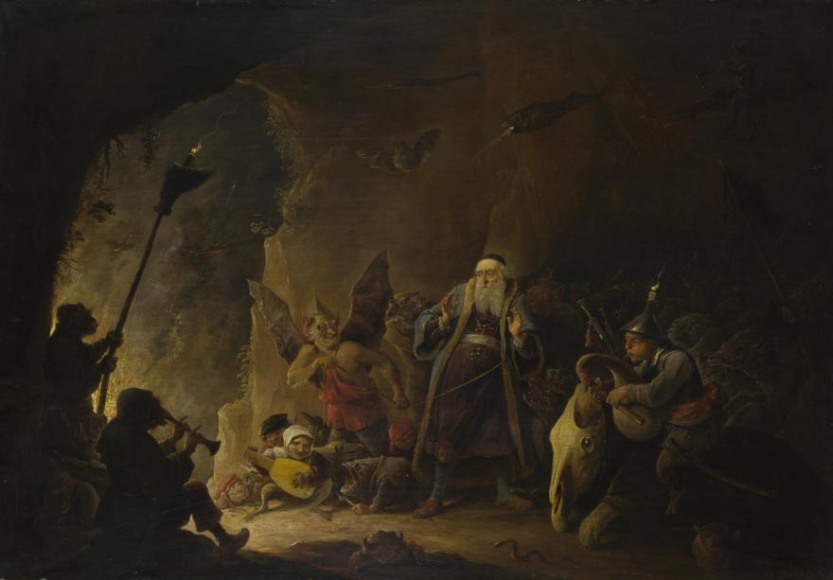In 1647, Flemish artist David Teniers the Younger (son-in-law of Jan Brueghel the Elder and grandson-in-law of Pieter Brueghel the Elder) painted an interesting Baroque rendition of Jesus’ parable of Lazarus and the Rich Man (Luke 16:19-31). The rich man, who dressed in purple and fine linen and lived a life of luxury, ignores the pleas of Lazarus the sore-covered beggar when he arrives at his door longing to eat the scraps fallings from his table. Soon, Lazarus dies and is lifted to Abraham’s side by angels whereas the rich man is condemned to hell, from where he looks up in the middle of great torment to converse with Abraham. Teniers captures the moment when he is standing at the entrance of hell, which he imagines as a cave surrounded by a variety of festive, frolicsome demons.

Here is an explanation:
The subject has an overall heavy, sinister and ominous tone to it and the intention of this painting is to depict the moralistic concepts of Jesus’ teachings with its strong emphasis on caring for others. […] There is a strong element of chiaroscuro which has the effect of bringing a dramatic notion to the scene. The hot iridescent orange glow emerging from hell illuminates the figures of the rich man and two of the demons. The enables Tenniers to highlight and pay particular attention to the expressions and features of these figures, enabling the observer to see the inner emotional anguish of the rich man whose facial expression reflects his fear at the prospect of his oncoming fate and his hands are raised in immense terror. It also enables the viewer to see the demons’ malevolent sneering expression at their delight in claiming a new victim to torture. They are very much reminiscent of Bosch’s winged demonic figures in their spectral and nightmarish forms and both of these qualities are further enhanced by the application of silhouette. The demons vary in height and there is only one short figure. The variations of levels in height remind one of the varying levels of punishment that the damned would be subjected to in hell. There is a considerable amount of space surrounding the main action which gives a sense of isolation, reflecting one of the emotions people would experience in hell. Despite the amount of space most of the figures are crowded together into one area, communicating the chaos and disorder of hell.
~ Sharon Noviss, Infinite Wisdom: A History of Christian Art (2012)
—-

It interesting the images that come to my mind the effect this painting, and the explanation, has on me. When I conjoined the two, the painting and the explanation, I can see a painting in my mind of the Spanish Inquisition where, supposed followers of Jesus, created their own hell on earth. They themselves, the priests and clerics, would be depicted as the demons with the “malevolent sneering expression at their delight in claiming a new victim to torture.”
I can also see a satirical modern painting, depicting Mormon church authorities, laughing and mocking the LGBT community, as they lay in a pit dying by their own hand. Begging for mercy and acceptance, only to receive coldhearted retorts from the church authorities stating, “We’re sorry but it is up to a “higher power.”
They claim to be the saviors from hell but instead, they are the creators of hell.
LikeLike
Unfortunately…
LikeLike
I’ve spoke of great art that touches the heart. Such a beautiful music. Then there is the art that disturbs the heart and mind. Both are equally powerful. At this time I find myself caught in the middle. The desire to create something beautiful but with images that torment me to be expressed that would be disturbing to others. This truly is the beautiful dilemma an artist has to experience. Shall I touch the hearts of others or, shall I disturb their hearts and cause them to think?
Thoughts and images whirl round and round within my mind, all desiring to be expressed at once. Soon they will come to settle in a place where I myself can actually interpret them. Usually my writing will fall in the middle somewhere. Disturbing to some but touches the hearts of others. Just as physicists seek the universal answer to everything, so the artist seeks that place where what is expressed is universally inspiring, rather than to be like much of humanity, who gather in groups and shun those who are not of their group.
LikeLike